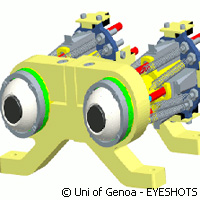EYESHOTS project delivers tactile solution
EU-funded researchers have made giant strides in their quest to control the interaction between movement and vision, replicating human behaviour in robots. How? They have developed a sophisticated three-dimensional visual system synchronised with robotic arms. The outcome is part of the EYESHOTS ('Heterogeneous 3D perception across visual fragments') project, which received EUR 2.4 million under the 'Information and communication technologies' (ICT) Theme of the EU's Seventh Framework Programme (FP7). This latest development could enable robots to see and be aware of their surroundings. It could also give these machines the edge in remembering the contents of those images so that they could act accordingly, the researchers say. Led by the Department of Biophysical and Electronic Engineering at the University of Genoa in Italy, the EYESHOTS partners say they had to refine the basic mechanisms of a humanoid robot to ensure the successful interaction of its environment with the autonomous tasks it must fulfil. For Ángel Pasqual del Pobil, head of the Spain-based Robotic Intelligence Laboratory of the Universitat Jaume I de Castellón, which is an EYESHOTS partner, his team validated the consortium's findings with a system developed at the university. This system comprises a torso with articulated arms and a robot head with moving eyes. The partners kicked off the development process by examining human and animal biology. Experts in robotics, neuroscience, engineering and psychology, the team members built the computer models by recording monkey's neurons engaged in visual-motor coordination. Humans and primates, say the partners, share the way in how the world is perceived. The first artificially replicated feature of the human visual system was our saccadic eye movement which is related to the dynamic change of attention, they say. 'We constantly change the point of view through very fast eye movements, so fast that we are hardly aware of it,' Dr Pobil says. 'When the eyes are moving, the image is blurred and we can't see clearly. Therefore, the brain must integrate the fragments as if it were a puzzle to give the impression of a continuous and perfect image of our surroundings.' Using the neural data, the team built computer models of the section of the brain that combines images with movements of both eyes and arms. According to them, this model is unique; the integration of images with movements confirms that when humans move to grasp an object, it is not necessary for our brain to calculate the coordinates. 'The truth is that the sequence is much more straightforward: our eyes look at a point and tell our arm where to go,' Dr Pobil explains. 'Babies learn this progressively by connecting neurons.' In a nutshell, the EYESHOTS partners have succeeded in simulating these learning mechanisms through a neural network, enabling robots to perform various tasks including constructing a representation of the environment, preserving the appropriate images and learning how to look. These robots also use their memory to reach for objects despite not being able to actually see them. 'Our findings can be applied to any future humanoid robot capable of moving its eyes and focusing on one point,' the Spanish researcher says. 'These are priority issues for the other mechanisms to work correctly.' The other partners of EYESHOTS are the University of Münster in Germany, the University of Bologna in Italy and Katholieke Universiteit Leuven in Belgium.For more information, please visit: EYESHOTS: http://www.eyeshots.it/ University of Genoa: http://www.unige.it/
Countries
Belgium, Germany, Spain, Italy



